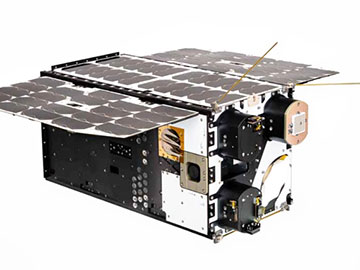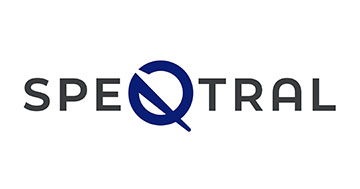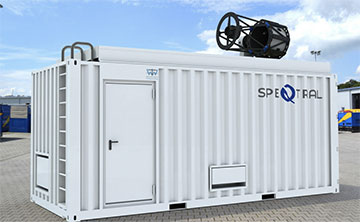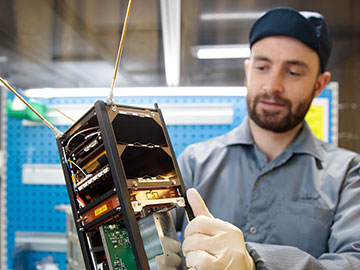Robert Bedington. [Image: SpeQtral]
As part of our biennial Entrepreneurs to Watch feature, Optics & Photonics News spoke with Robert Bedington, cofounder and CTO of SpeQtral, a Singapore-based quantum communications company developing satellite-based quantum key distribution (QKD) systems. SpeQtral emerged from academic research into entangled photon sources and is now on the verge of launching one of the first commercial QKD satellites outside of China.
Tell me about your journey into entrepreneurship. How did you get started?
My background is in physics. I studied at Durham University, UK, where I focused on astronomical instrumentation for my master’s project. That led me to pursue a Ph.D. at University College London’s Mullard Space Science Laboratory, working on satellite-based space weather analyzers—electron and ion spectrometers for small satellites.
Later, I did a postdoc in Japan, continuing the miniaturization of those devices. Around that time, I reconnected with an old school friend who had moved to Singapore and was working at the Centre for Quantum Technologies (CQT) at the National University of Singapore. He told me they were developing miniaturized quantum experiments for space and needed someone with satellite experience. That’s how I joined the team.
At CQT, we developed a 3U CubeSat called SpooQy-1, a 30×10×10 cm satellite that demonstrated quantum entanglement in orbit. I led the satellite team under Professor Alexander Ling. We built a robust entangled photon source and integrated it into the satellite, which launched in 2019 via the Japanese Space Agency and deployed from the International Space Station. It operated until it deorbited in 2021 and successfully demonstrated quantum entanglement in space throughout that time.
And that was the catalyst for launching the company?
Exactly. SpooQy-1 generated a lot of commercial interest. People kept asking if they could buy one of these QKD satellites, and we’d say, “We’re a university. We don’t sell satellites.” But that got us thinking.

SpeQtral-1 satellite. [Image: SpeQtral]
In late 2017, we set up a company called S15 Space Systems—named after the university block we worked in: Science Site 15. At first, we collaborated closely with the university, handling contracted research and satellite operations. Then in 2019, after securing funding, we acquired our own offices and labs and transitioned the team into what’s now SpeQtral.
So it was a natural progression from research group to startup…
Very much so. The research group always had a startup-like atmosphere. We were a team of postdocs and researchers working toward the shared goal of launching a satellite. That’s not so typical in academia, where people usually have individual projects. So when the time came to spin out, the transition felt organic.
Tell me more about the technology. Why is quantum entanglement in space important?
The near-term application is quantum key distribution, or QKD. It’s a method of securely sharing random numbers—used as encryption keys—between two parties. What makes QKD different is that it’s based on the laws of quantum physics. Any eavesdropping attempt disturbs the system and is detectable.
This is especially relevant because current encryption relies on mathematical complexity—things like factoring large primes—which quantum computers will eventually break. With QKD, the security isn’t based on assumptions or computational difficulty. The method is proven to be secure from the outset.
So this is about future-proofing encryption—especially for critical infrastructure.
Yes, it’s not about protecting casual web browsing. It’s about securing high-value data—banking systems, government communications, data center interconnects. And banks are already early adopters. I just came back from a banking conference where interest was high.
How is SpeQtral’s approach unique in optics and photonics?
Our systems are much smaller and more cost-effective than existing solutions. There are only a handful of serious efforts in satellite QKD—most notably China’s Micius satellite, which demonstrated QKD in 2017.

[Image: SpeQtral]
Outside of that, there have only been partial demos. SpooQy-1, for instance, was an early proof of concept. Some German and other European efforts have followed, but no one else has yet matched China’s full-scale entanglement distribution missions.
We’ll likely be among the first to follow. Our mission, launching later this year, uses entanglement-based QKD—a more secure but technically complex approach. Many systems use “weak coherent pulses,” which approximate single photons. These are easier to implement but have weaker security guarantees. Our system starts with true entangled photon pairs, which can enable secure key exchange even without trusting the satellite—though our first mission will still require some trust.
That sounds like a significant milestone. When is the launch?
The window is October to November 2025. After that, we’ll enter a commissioning phase that could take three to six months. Like many satellite programs, deadlines shift, but we’re getting close.
What’s been the biggest challenge since launching SpeQtral?
Many, honestly. The technology is complex, but the business side presents its own hurdles. QKD doesn’t replace an existing system directly—it supplements existing cryptography. So productizing it, explaining it, integrating it into broader security infrastructures… all of that takes time and coordination.
Certification, standardization, export controls—these are dry but critical aspects that we and others in the QKD field are still working through.
Hiring has also been hard. During the pandemic, it was tough to attract people to Singapore, especially because much of our work is hands-on. Even seemingly minor things, like changes to spousal work visas, made a big impact. Still, we’ve built a strong, international team.
And because we work with global partners—most of them in Europe—we face the usual challenges of remote technical collaboration across time zones. It takes a lot of effort to make those relationships run smoothly.
As a leader, what do you wish you’d known at the beginning?
That it’s okay to deliver value in smaller steps. We jumped straight into satellites. Looking back, I think we could have prioritized intermediate deliverables—smaller, more immediate revenue-generating products that build toward the big vision.
We’ve done some of that, but I’d put more emphasis on it next time. It helps with funding, morale, and customer engagement.
How do you keep innovation alive in this kind of environment?
Innovation is baked into our DNA. We didn’t really start from scratch—we spun out from a research group. So there’s always been a culture of experimentation and pushing boundaries.
But we also brought in people from industry to help make things robust, reliable, and commercially viable. It’s a balance—keeping the academic curiosity while building a company that ships.

TARQIS, SpeQtral’s Mobile Quantum Optical Ground Station (Q-OGS). [Image: SpeQtral]
What happens after this year’s launch? What’s next for you and SpeQtral?
We’re already working on the follow-on mission. It will include both an entangled photon source and a weak coherent pulse source. The latter can deliver higher key rates, though with slightly less security.
We’re also integrating laser communications, which will replace radio links and increase data rates significantly.
Longer term, we’re exploring a range of quantum-based key distribution techniques. Not every use case needs the gold standard. Some commercial clients may not face the kind of threats that justify the most secure (and expensive) systems. So we’re thinking about cost-performance trade-offs and tailoring solutions to different needs.
You’re talking about a spectrum of solutions, depending on the risk model.
Exactly. Not everyone needs to protect against the threat of stealth satellites or hypersonic drones as potential eavesdroppers. If your adversaries are less advanced, a lower-cost solution might be enough.
We want to help customers understand their threat models so they can choose the right level of quantum security.
What trends are shaping the future of your industry?
The biggest one is, of course, quantum computing. It’s still early days, but it will eventually break current encryption. That’s why organizations are acting now to secure critical communications.
Even if quantum computing is still five or ten years off, the data you transmit today can be stored and decrypted later. That’s what people call “harvest now, decrypt later.”
Further out, we’re looking at quantum networking—linking quantum computers over entangled networks. That would enable shared computation and massive increases in capability. Imagine entangling telescopes on opposite sides of the planet to create a virtual telescope the size of the Earth.
That’s decades away, but the infrastructure we’re building now—satellite QKD, entangled photon networks—is the foundation for that future. There’s a long road ahead, but also incredible potential. We’re trying to help build the quantum internet, piece by piece.
